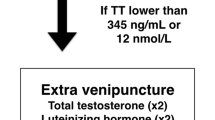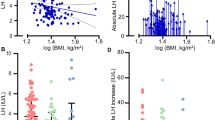Abstract
Although male hypogonadism (MH) is a prevalent comorbidity in patients presenting for erectile dysfunction (ED), its screening relies solely on total testosterone (TT). Ageing and other conditions can increase sex hormone-binding globulin (SHBG) and lower free testosterone (FT) causing symptomatic MH despite normal TT. The primary objective was to measure the prevalence of normal TT/low FT among patients presenting for ED. From January 2019 to December 2020, 408 patients referred for sexual dysfunction were screened; 180 men with a confirmed diagnosis of ED were included. MH was screened using TT, SHBG, albumin and LH. FT was calculated (cFT). Low TT, high SHBG and low cFT were defined as <345 ng/dL, >50 nmol/L and <6.5 ng/dL, respectively. Patients were divided into groups according to TT/cFT status and to age group. The frequency of normal TT/low cFT was 17.2%. From all 31 patients with normal TT/low cFT, only four (12.9%) had either hyperthyroidism, hepatic disease or HIV infection, while 23 (74.2%) were older than 60 years. Patients with normal TT/low cFT were older (65.57 ± 10.43 vs. 56.79 ± 10.63 yo, p = 0.001) and had higher SHBG (78.48 ± 40.14 vs. 52.35 ± 20.39 nmol/L, p = 0.014) than patients with normal TT/cFT. Patients over 60 years represented 48.9% of the sample, 52.5% had elevated SHBG and their frequency of normal TT/low cFT was 26.3%. Normal TT/low cFT is frequent and can be missed by current screening recommendations for MH in patients presenting for ED. Ageing seems to be the main culprit as elevated SHBG prevalence increases steeply after the sixth decade. TT cannot solely be relied on to exclude biochemical MH in patients presenting for ED, especially in patients over 60 years old. Current guidelines for MH screening in ED should be amended.
This is a preview of subscription content, access via your institution
Access options
Subscribe to this journal
Receive 8 print issues and online access
$259.00 per year
only $32.38 per issue
Buy this article
- Purchase on Springer Link
- Instant access to full article PDF
Prices may be subject to local taxes which are calculated during checkout

Similar content being viewed by others
Data availability
The data that support the findings of this study are available from the corresponding author, AM, upon reasonable request. The data are not publicly available due to privacy restrictions.
References
Dohle GR, Arver S, Bettocchi C, Jones TH, Kliesch S. Male Hypogonadism - March 2018. In: Office EG, editor. EAU Guidelines. Edn. presented at the EAU Annual Congress Barcelona, The Netherlands; Arnhem; EAU Guidelines Office, 2019 ed2019. https://d56bochluxqnz.cloudfront.net/media/EAU-Guidelines-on-Male-Hypogonadism-2019v2.pdf.
Kohler TS, Kim J, Feia K, Bodie J, Johnson N, Makhlouf A, et al. Prevalence of androgen deficiency in men with erectile dysfunction. Urology. 2008;71:693–7.
Maseroli E, Corona G, Rastrelli G, Lotti F, Cipriani S, Forti G, et al. Prevalence of endocrine and metabolic disorders in subjects with erectile dysfunction: a comparative study. J Sex Med. 2015;12:956–65.
Morgado A, Moura ML, Dinis P, Silva CM. Current stepwise recommendations for hypogonadism screening in erectile dysfunction are not cost-effective. Int J Impot Res. 2020;32:297–301.
Corona G, Maggi M. The role of testosterone in erectile dysfunction. Nat Rev Urol. 2010;7:46–56.
Corona G, Isidori AM, Aversa A, Burnett AL, Maggi M. Endocrinologic Control of Men’s Sexual Desire and Arousal/Erection. J Sex Med. 2016;13:317–37.
Dean JD, McMahon CG, Guay AT, Morgentaler A, Althof SE, Becher EF, et al. The International Society for Sexual Medicine’s Process of Care for the Assessment and Management of Testosterone Deficiency in Adult Men. J Sex Med. 2015;12:1660–86.
Burnett AL, Nehra A, Breau RH, Culkin DJ, Faraday MM, Hakim LS, et al. Erectile Dysfunction: AUA Guideline. J Urol. 2018;200:633–41.
Salonia A, Bettocchi C, Boeri L, Capogrosso P, Carvalho J, Cilesiz NC, et al. European Association of Urology Guidelines on Sexual and Reproductive Health-2021 Update: Male Sexual Dysfunction. Eur Urol. 2021.
Boeri L, Capogrosso P, Ventimiglia E, Cazzaniga W, Pederzoli F, Moretti D, et al. Does Calculated Free Testosterone Overcome Total Testosterone in Protecting From Sexual Symptom Impairment? Findings of a Cross-Sectional Study. J Sex Med. 2017;14:1549–57.
Rosner W, Vesper H, Endocrine S, American Association for Clinical C, American Association of Clinical E, Androgen Excess PS. et al. Toward excellence in testosterone testing: a consensus statement. J Clin Endocrinol Metab. 2010;95:4542–8.
Miller WL, Auchus RJ. The molecular biology, biochemistry, and physiology of human steroidogenesis and its disorders. Endocr Rev. 2011;32:81–151.
Araujo AB, Wittert GA. Endocrinology of the aging male. Best Pr Res Clin Endocrinol Metab. 2011;25:303–19.
Wu FC, Tajar A, Pye SR, Silman AJ, Finn JD, O’Neill TW, et al. Hypothalamic-pituitary-testicular axis disruptions in older men are differentially linked to age and modifiable risk factors: the European Male Aging Study. J Clin Endocrinol Metab. 2008;93:2737–45.
Liu PY, Beilin J, Meier C, Nguyen TV, Center JR, Leedman PJ, et al. Age-related changes in serum testosterone and sex hormone binding globulin in Australian men: longitudinal analyses of two geographically separate regional cohorts. J Clin Endocrinol Metab. 2007;92:3599–603.
Organization WH. ICD-10: international statistical classification of diseases and related health problems: tenth revision. 2nd. World Health Organization; 2004.
Charlson ME, Pompei P, Ales KL, MacKenzie CR. A new method of classifying prognostic comorbidity in longitudinal studies: development and validation. J Chronic Dis. 1987;40:373–83.
Rosen RC, Cappelleri JC, Smith MD, Lipsky J, Pena BM. Development and evaluation of an abridged, 5-item version of the International Index of Erectile Function (IIEF-5) as a diagnostic tool for erectile dysfunction. Int J Impot Res. 1999;11:319–26.
Santos Pechorro P, Martins Calvinho A, Monteiro Pereira N, Xavier Vieira R. Validação de uma versão portuguesa do Índice Internacional de Função Eréctil-5 (IIEF-5). Rev Internacional de Andrología. 2011;9:3–9.
American Psychiatric Association D-TF. Diagnostic and statistical manual of mental disorders: DSM-5™. 5th ed. American Psychiatric Publishing, Inc; 2013.
Vermeulen A, Verdonck L, Kaufman JM. A critical evaluation of simple methods for the estimation of free testosterone in serum. J Clin Endocrinol Metab. 1999;84:3666–72.
Grundy SM, Stone NJ, Bailey AL, Beam C, Birtcher KK, Blumenthal RS, et al. 2018 AHA/ACC/AACVPR/AAPA/ABC/ACPM/ADA/AGS/APhA/ASPC/NLA/PCNA Guideline on the Management of Blood Cholesterol: A Report of the American College of Cardiology/American Heart Association Task Force on Clinical Practice Guidelines. Circulation. 2019;139:e1082–e143.
Williams B, Mancia G, Spiering W, Agabiti Rosei E, Azizi M, Burnier M, et al. 2018 ESC/ESH Guidelines for the management of arterial hypertension. Eur Heart J. 2018;39:3021–104.
Grant PJ, Cosentino F. The 2019 ESC Guidelines on diabetes, pre-diabetes, and cardiovascular diseases developed in collaboration with the EASD: New features and the ‘Ten Commandments’ of the 2019 Guidelines are discussed by Professor Peter J. Grant and Professor Francesco Cosentino, the Task Force chairmen. Eur Heart J. 2019;40:3215–7.
El-Sakka AI, Hassoba HM. Age related testosterone depletion in patients with erectile dysfunction. J Urol. 2006;176:2589–93.
Handelsman DJ, Sikaris K, Ly LP. Estimating age-specific trends in circulating testosterone and sex hormone-binding globulin in males and females across the lifespan. Ann Clin Biochem. 2016;53:377–84.
Pagano MJ, De Fazio A, Levy A, RoyChoudhury A, Stahl PJ. Age, Body Mass Index, and Frequency of Sexual Activity are Independent Predictors of Testosterone Deficiency in Men With Erectile Dysfunction. Urology. 2016;90:112–8.
Capogrosso P, Ventimiglia E, Boeri L, Cazzaniga W, Chierigo F, Pederzoli F, et al. Age at First Presentation for Erectile Dysfunction: Analysis of Changes over a 12-yr Period. Eur Urol Focus. 2019;5:899–905.
Yeap BB, Almeida OP, Hyde Z, Norman PE, Chubb SA, Jamrozik K, et al. In men older than 70 years, total testosterone remains stable while free testosterone declines with age. The Health in Men Study. Eur J Endocrinol. 2007;156:585–94.
Isidori AM, Buvat J, Corona G, Goldstein I, Jannini EA, Lenzi A, et al. A critical analysis of the role of testosterone in erectile function: from pathophysiology to treatment-a systematic review. Eur Urol. 2014;65:99–112.
Laurent MR, Hammond GL, Blokland M, Jardi F, Antonio L, Dubois V, et al. Sex hormone-binding globulin regulation of androgen bioactivity in vivo: validation of the free hormone hypothesis. Sci Rep. 2016;6:35539.
Corona G, Maseroli E, Rastrelli G, Sforza A, Forti G, Mannucci E, et al. Characteristics of compensated hypogonadism in patients with sexual dysfunction. J Sex Med. 2014;11:1823–34.
Antonio L, Wu FC, O’Neill TW, Pye SR, Ahern TB, Laurent MR, et al. Low Free Testosterone Is Associated with Hypogonadal Signs and Symptoms in Men with Normal Total Testosterone. J Clin Endocrinol Metab. 2016;101:2647–57.
Ventimiglia E, Ippolito S, Capogrosso P, Pederzoli F, Cazzaniga W, Boeri L, et al. Primary, secondary and compensated hypogonadism: a novel risk stratification for infertile men. Andrology. 2017;5:505–10.
Park K, Ku JH, Kim SW, Paick JS. Risk factors in predicting a poor response to sildenafil citrate in elderly men with erectile dysfunction. BJU Int. 2005;95:366–70.
Araujo AB, Esche GR, Kupelian V, O’Donnell AB, Travison TG, Williams RE, et al. Prevalence of symptomatic androgen deficiency in men. J Clin Endocrinol Metab. 2007;92:4241–7.
Eriksson AL, Lorentzon M, Mellstrom D, Vandenput L, Swanson C, Andersson N, et al. SHBG gene promoter polymorphisms in men are associated with serum sex hormone-binding globulin, androgen and androgen metabolite levels, and hip bone mineral density. J Clin Endocrinol Metab. 2006;91:5029–37.
Stanworth RD, Kapoor D, Channer KS, Jones TH. Androgen receptor CAG repeat polymorphism is associated with serum testosterone levels, obesity and serum leptin in men with type 2 diabetes. Eur J Endocrinol. 2008;159:739–46.
Morgado A, Moura ML, Dinis P, Silva CM. Misdiagnosis And Undertreatment Of Erectile Dysfunction In The Portuguese Primary Health Care. Sex Med. 2019;7:177–83.
Alarcao V, Ribeiro S, Miranda FL, Carreira M, Dias T, Garcia e Costa J, et al. General practitioners’ knowledge, attitudes, beliefs, and practices in the management of sexual dysfunction-results of the Portuguese SEXOS study. J Sex Med. 2012;9:2508–15.
Acknowledgements
The authors would like to acknowledge Maria Leonor Moura’s contribution in data collection and nurse Adelaide Coutinho contribution during patient’s baseline assessment.
Author information
Authors and Affiliations
Contributions
AM designed the research study, AM & AS performed the research, AM, AS & CS analysed the data; AM drafted the paper; AS & CS reviewed it critically. All authors approve the submitted and full version of the paper.
Corresponding author
Ethics declarations
Competing interests
The authors declare no competing interests.
Additional information
Publisher’s note Springer Nature remains neutral with regard to jurisdictional claims in published maps and institutional affiliations.
Supplementary information
Rights and permissions
About this article
Cite this article
Morgado, A., Silva, A.C., Diniz, P. et al. Can we rely on total testosterone measurement to exclude hypogonadism in erectile dysfunction?. Int J Impot Res 35, 454–459 (2023). https://doi.org/10.1038/s41443-022-00565-5
Received:
Revised:
Accepted:
Published:
Issue Date:
DOI: https://doi.org/10.1038/s41443-022-00565-5



